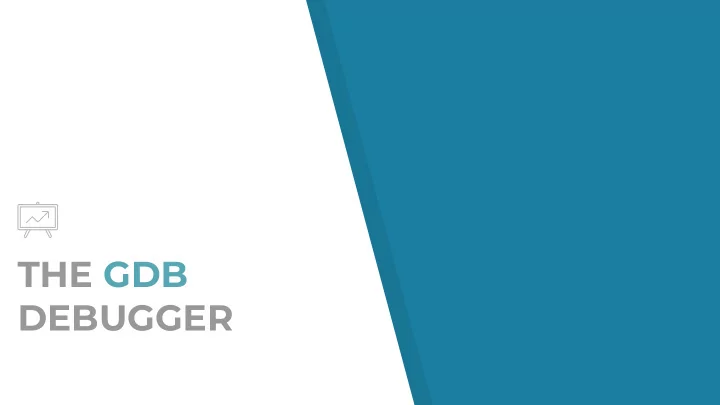

THE GDB DEBUGGER
GDB Debuggers allow you to examine and control program execution To compile a program for use with gdb, use the ‘-g’ compiler switch Most debuggers provide the same functionality ▸ Other graphical options on MCECS Linux systems gdb -tui ▸ http://beej.us/guide/bggdb/ ▹ DDD ▸ Eclipse ▸ http://www.gnu.org/software/ddd/Eclipse ▹ 2
CONTROLLING PROGRAM EXECUTION run Starts the program ▸ step Execute until a different source line reached (step into calls) ▸ next Execute until next source line reached, proceeding through subroutine calls ▸ continue Resume program execution until signal or breakpoint ▸ break, del Set and delete breakpoints at particular lines of code ▸ 3
CONTROLLING PROGRAM EXECUTION watch, rwatch, awatch Data breakpoints ▸ Stop when the value of an expression ▸ changes (watch) ▹ is read (rwatch) ▹ either (awatch) ▹ 4
DISPLAYING DATA print Print expression ▸ Basic ▸ print argc ▹ print argv[0] ▹ print $rsp ▹ print /x addr ▸ ‘/x’ says to print in hex. See “help x” for more formats ▹ Same as examine memory address command ( x ) ▹ printf “format string” arg-list ▸ (gdb) printf "%s\n", argv[0] ▹ x (examine) Examine memory ▸ x /s $rax => print the string at address contained in %rax ▹ x /32xw 0x4006b7 => print 32 words at 0x4006b7 in hexadecimal ▹ 5
DISPLAYING CODE list Display source code (useful for setting breakpoints) ▸ Requires -g ▸ disassemble <fn> Disassemble C function fn ▸ 6
OTHER USEFUL COMMANDS where, backtrace Produces a backtrace - the chain of function calls that brought the program ▸ to its current place. up, down Change scope in stack ▸ info Get information ▸ ‘info’ alone prints a list of info commands ▸ ‘info br’ : a table of all breakpoints and watchpoints ▸ ‘info reg’ : the machine registers ▸ quit Exit the debugger ▸ 7
GDB TUI layout <cmd> split (creates a split screen with multiple panes) ▸ asm (loads assembly up in a pane) ▸ regs (loads registers up in a pane) ▸ focus <pane> Puts focus onto a particular pane (cmd, asm, regs) ▸ 8
Recommend
More recommend